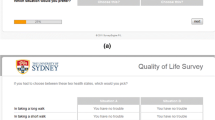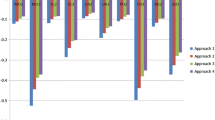Abstract
Background
Discrete choice experiments with duration (DCETTO) can be used to estimate utility values for preference-based measures, such as the EQ-5D-5L. For self-completion, the health dimensions are presented in a standard order. However, for valuation, this may result in order effects. Thus, it is important to understand whether health state dimension ordering affects values. The aim of this study was to examine the importance of dimension ordering on DCE values using EQ-5D-5L.
Methods
A choice experiment presenting two health profiles and a third immediate death option was developed. A three-arm study was used, with the same 120 choice sets presented online across each arm (n = 360 per arm). Arm 1 presented the standard EQ-5D-5L dimension order, arm 2 randomised order between respondents, and arm 3 randomised within respondents. Conditional logit regression was used to assess model consistency, and scale parameter testing was used to assess model poolability.
Results
There were minor inconsistencies across each arm, but the magnitudes of the coefficients produced were generally consistent. Arm 3 produced the largest range of utility values (1 to −0.980). Scale parameter testing suggested that the models did not differ, and the data could be pooled. Follow-up questions did not suggest variation in terms of difficulty.
Conclusions
The results suggest that the level of randomisation used in DCE health state valuation studies does not significantly impact values, and dimension order may not be as important as other study design issues. The results support past valuation studies that use the standard order of dimensions.



Similar content being viewed by others
References
Brooks R. EuroQol: the current state of play. Health Policy. 1996;37:53–72.
Brazier J, Roberts J, Deverill M. The estimation of a preference-based measure of health from the SF-36. J Health Econ. 2002;21:271–92.
Brazier J, Roberts J. Estimating a preference-based index from the SF-12. Med Care. 2002;42(9):851–9.
Dolan P. Modeling valuations for EuroQol health states. Med Care. 1997;35(11):1095–108.
Stolk EA, Oppe M, Scalone L, Krabbe P. Discrete choice modeling for the quantification of health states: the case of the EQ-5D. Value Health. 2010;13(8):1005–13.
Bansback N, Brazier J, Tsuchiya A, Anis A. Using a discrete choice experiment to estimate societal health state utility values. J Health Econ. 2012;31(1):306–18.
Viney R, Norman R, Brazier J, Cronin P, King M, Ratcliffe J, et al. An Australian discrete choice experiment to value EQ-5D health states. Health Econ. 2013;23:729–42.
Norman R, Cronin P, Viney R. A pilot discrete choice experiment to explore preferences for EQ-5D-5L health states. Appl Health Econ Health Policy. 2013;11(3):287–98.
Bansback N, Hole AR, Mulhern B, Tsuchiya A. Testing a discrete choice experiment including duration to value health states for large descriptive systems: addressing design and sampling issues. Soc Sci Med. 2014;114:38–48.
Mulhern B, Bansback N, Brazier J, Buckingham K, Cairns J, Devlin N, et al. Preparatory study for the revaluation of the EQ-5D tariff: methodology report. Health Technol Assess. 2014;18:12.
Norman R, Viney R, Brazier J, Burgess L, Cronin P, King M, et al. Valuing SF-6D health states using a discrete choice experiment. Med Decis Mak. 2014;34(6):773–86.
Tsuchiya A, Mulhern B, Bansback N, Hole AR. Using DCE with duration to examine the robustness of preferences across the five dimensions of the EuroQol instrument: the second paper from the FEDEV project. EuroQol Group Plenary Proceedings. 2014.
Mulhern B, Shah K, Janssen MF, Longworth L. Valuing health using time trade off and discrete choice methods: does dimension order impact on health state values? Value Health. 2016;19(2):210–7.
Norman R, Kemmler G, Viney R, Pickard AS, Gamper E, Holzner B, Nerich V, King M. Order of presentation of dimensions does not systematically bias utility weights from a discrete choice experiment. Value Health. (In press).
Kjaer T, Bech M, Gyrd-Hansen D, Hart-Hansen K. Ordering effect and price sensitivity in discrete choice experiments: need we worry? Health Econ. 2006;15(11):1217–28.
Swait J, Louviere J. The role of the scale parameter in the estimation and comparison of multinomial logit models. J Mark Res. 1993;30(3):305–14.
Viney R, Savage E, Louviere J. Empirical investigation of experimental design properties of discrete choice experiments in health care. Health Econ. 2005;14:349–62.
Herdman M, Gudex C, Lloyd A, Janssen MF, Kind P, Parkin D, et al. Development and preliminary testing of the new five-level version of EQ-5D (EQ-5D-5L). Qual Life Res. 2011;20(10):1727–36.
Norman R, Mulhern B, Viney R. The impact of different DCE-based approaches when anchoring utility scores. Pharmacoeconomics. 2016;34(8):805–14.
ChoiceMetrics. Ngene [software for experimental design]. NGene; 2012.
StataCorp. Stata statistical software: release 13. College Station: StataCorp LP; 2013.
Mulhern B, Bansback N, Hole AR, Tsuchiya A. Using discrete choice experiment with duration to model EQ-5D-5L health state preferences: testing experimental design strategies. Med Decis Mak. 2016. (In press).
Viney R, Mulhern B, Norman N, Shah K, Bansback N, Longworth L. Using DCE with duration to value EQ-5D-5L: investigating task presentation. Berlin: EuroQol Group Plenary; 2016.
Craig BM, Pickard AS, Rand-Hendriksen K. Do health preferences contradict ordering of EQ-5D labels? Qual Life Res. 2015;24(7):1759–65.
Oppe M, Devlin NJ, van Hout B, Krabbe PFM, de Charro F. A program of methodological research to arrive at the new international EQ-5D-5L valuation protocol. Value Health. 2014;17:445–53.
Krucien N, Ryan M, Hermens F. Using eye-tracking methods to inform decision making processes in discrete choice experiments. Health Economist’s Study Group; 2014.
Acknowledgements
This study was funded by the Australian National Health and Medical Research Council. Authors BM, RN and RV led the development of the study design, led the data collection and analysis, and drafted the first version of the manuscript. Authors JR, JB, EL and PL contributed to the development of the study design, supported the data analysis and interpretation of the results, and provided detailed revisions of earlier versions of the manuscript.
Author information
Authors and Affiliations
Corresponding author
Ethics declarations
All procedures performed in studies involving human participants were in accordance with the ethical standards of the institutional research committee [University of Technology Sydney Human Research Ethics Committee (Program Approval Number 2015000135)]. The following authors are members of the EuroQol Research Foundation (the copyright holders of EQ-5D-5L): Brendan Mulhern, Richard Norman, John Brazier, and Rosalie Viney. There are no other conflicts of interest.
Rights and permissions
About this article
Cite this article
Mulhern, B., Norman, R., Lorgelly, P. et al. Is Dimension Order Important when Valuing Health States Using Discrete Choice Experiments Including Duration?. PharmacoEconomics 35, 439–451 (2017). https://doi.org/10.1007/s40273-016-0475-z
Published:
Issue Date:
DOI: https://doi.org/10.1007/s40273-016-0475-z




